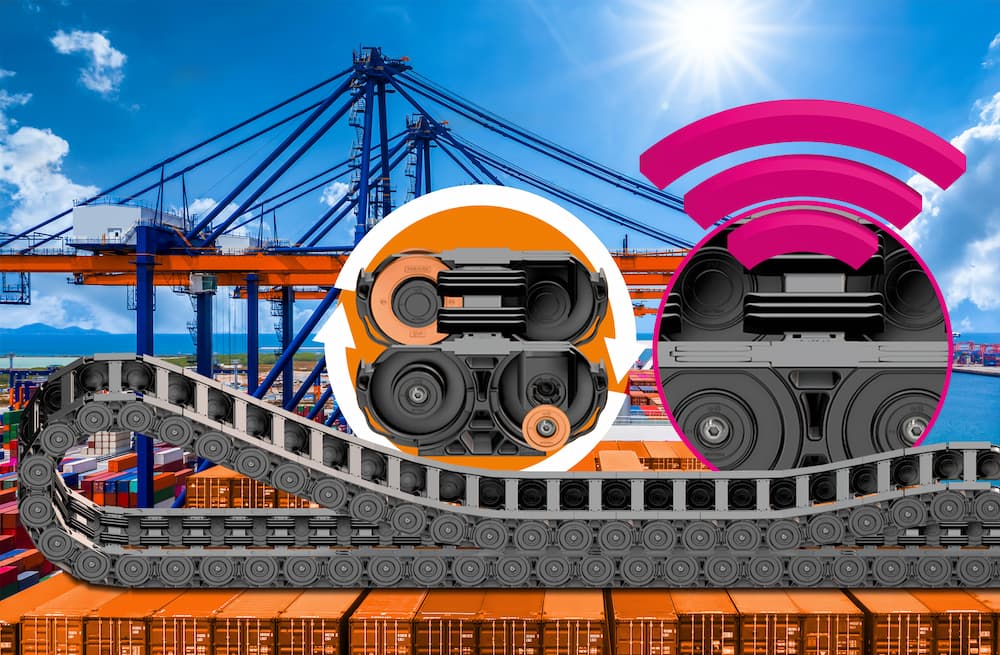STS container cranes: new heavy-duty roller chain from igus helps future-proof tomorrow’s ports
01/11/2022

The P4HD.56.R energy chain designed for container cranes is built for long travel distances, high speeds, heavy cable fills and Industry 4.0 connectivity to prevent costly failures
Container cranes in busy commercial ports will be even faster and more powerful in the future. In response igus has launched P4HD.56. R – a new heavy-duty energy chain, prepared for long distances, high speeds, heavy cable fills and “Industry 4.0” functions, and with 50% longer service life than the previous variant.
Commercial ports globally are experiencing demand for more capacity and higher ship turnover. Modern container ships such as the Evergreen A-class ship “Ever Ace”, are 400 metres long, 62 metres wide and load almost 24,000 containers. These gigantic vessels need bigger Ship-to-Shore (STS) cranes to load and unload the containers. Bigger cranes affect the energy chains that guide the energy and data cables along the loading boom of the crane.
These new generation cranes must withstand unprecedented loads: travel distances over 130m, cable fill weights of up to 10kg/m or (for motor-driven cats) over 20kg/m, as well as speeds of more than 1m/sec2 are the standard for Triple E Class STS cranes.
In other applications, travel distances of several hundred metres, cable fill weights of up to 50 kg/m and accelerations of 8 m/sec2 and more are possible. “For these extreme requirements, igus has developed the new heavy-duty energy chain P4HD.56. R,” says Justin Leonard, director of e-chains at igus UK. “This energy chain is particularly robust and, thanks to sensor technology, is designed for Industry 4.0 practices, in this case predictive maintenance – it can detect and prevent some failures in advance. This combination significantly increases the reliability of STS cranes and minimises very costly downtime.”
Heavy-duty energy chain can run smoothly for up to 15 years
For STS cranes to achieve a long service life under very high loads, the engineers have come up with some clever design “tricks”. “A special undercut design ensures even more stability at higher fill weights; and the pin-bore connection made of tribologically-optimised plastic offers minimal wear,” explains Leonard.
In addition, the rollers are mounted along the inner radius of the chain links; the upper run of the e-chain links rolls on the lower run instead of gliding. So, thanks to the low coefficient of friction, it is possible to increase the both payload and acceleration while maintaining the same push-pull force. Long term tests in igus’ in-house laboratory have proven that the heavy-duty P4HD.56. R e-chain achieves a 50% longer service life compared to the normal P41.56R variant.
“Our goal is for the e-chain systems on each STS crane to run for up to 15-years, trouble-free and with minimal maintenance,” says Leonard. A nice side benefit of this engineering is that the rolling movement reduces the required drive energy by 57%. With higher energy prices, this is a big plus for port operators. Since crane systems also require large cables, where long travel distances and high dynamics must be achieved, igus also offers CFCRANE, a chainflex cable program that has been specially developed for crane applications.
Fit for Industry 4.0
But the new P4HD.56.R e-chain is not only robust, durable and energy-saving. This heavy-duty energy chain is also suitable for Industry 4.0, by enabling predictive maintenance. With the help of igus i.Sense monitoring sensors, the status of the chain links can be continuously transmitted to the i.Cee:plus communication module. The i.Cee module means operators can rely on usage- and condition-based maintenance and thus extend the intervals between maintenance inspections. Maintenance is only necessary when the system gives a corresponding signal.
Operators of STS cranes can use the i.Cee system to significantly increase plant availability and extend the service life of the energy chains. Planned downtimes are automatically factored into the service life calculation by i.Cee, and the predicted system condition is constantly checked by means of sensors. An advantage of this is that the user does not lose any internal space, because the condition sensors and their electronics are integrated into the roller chain links to save space. Additional cables are not required, because the data transmission takes place via radio. “This means that the new e-chains of the P4HD.56.R series meet all the requirements that apply to STS cranes of the next generation and beyond, making them future-proof for the needs of modern busy ports,” says Justin Leonard.
